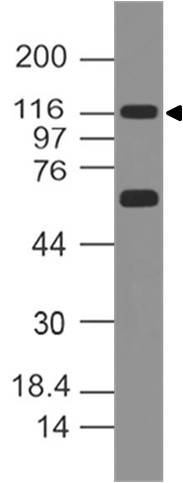Polyclonal Antibody to Mouse TLR9

Figure-1: Western blot analysis of mTLR9. Anti- mTLR9 antibody (11-3036) was used at 2 µg/ml on (1) m Thymus, (2) m Spleen, (3) m Testis, (4) m Liver and (5) m Stomach lysates.
Roll over image to zoom in
Shipping Info:
Order now and get it on Tuesday April 22, 2025
Same day delivery FREE on San Diego area orders placed by 1.00 PM
| Format : | Purified |
| Amount : | 100 µg |
| Isotype : | Rabbit IgG |
| Purification : | Protein A Chromatography |
| Content : | 25 µg in 50 µl/100 µg in 200 µl PBS containing 0.05% BSA and 0.05% sodium azide. Sodium azide is highly toxic. |
| Storage condition : | Store the antibody at 4°C, stable for 6 months. For long-term storage, store at -20°C. Avoid repeated freeze and thaw cycles. |
TLR9, a member of toll-like receptor family are central to the innate immunity by identifying pathogen associated molecular patterns (PAMPs). TLR9 identify unmethylated CpG dinucleotides present in bacterial DNA leading to NF-kB activation.
Western blot analysis: 1-2 µg/ml
For Research Use Only. Not for use in diagnostic/therapeutics procedures.
| Subcellular location: | Endoplasmic reticulum membrane, Endosome, Lysosome, Cytoplasmic vesicle |
| Post transnational modification: | Activated by proteolytic cleavage of the flexible loop between repeats LRR14 and LRR15 within the ectodomain (PubMed:18931679, PubMed:18820679). Cleavage requires UNC93B1 (PubMed:18820679). Proteolytically processed by first removing the majority of the ectodomain by either asparagine endopeptidase (AEP) or a cathepsin followed by a trimming event that is solely cathepsin mediated and required for optimal receptor signaling (PubMed:21402738). |
| Tissue Specificity: | Expressed in the basolateral region of gastric epithelial cells with high levels detected in antrum and body mucosa (at protein level). Detected in spleen and stomach at higher levels in C57BL/6 mice than BALB/C. |
| BioGrid: | 219897. 1 interactions. |
|
There are currently no product reviews
|















.png)









